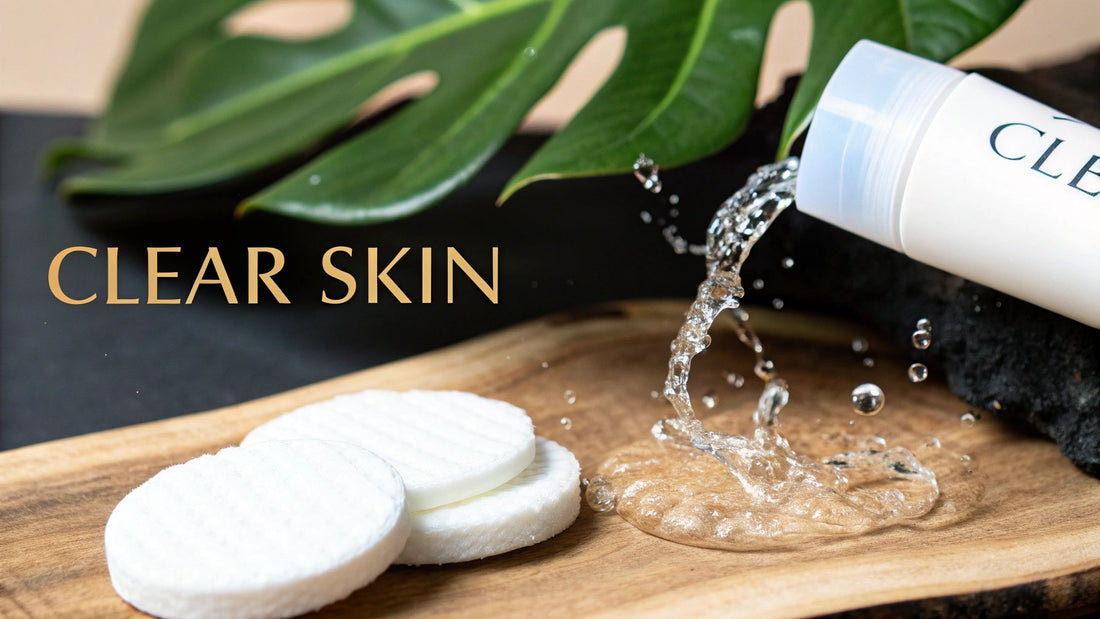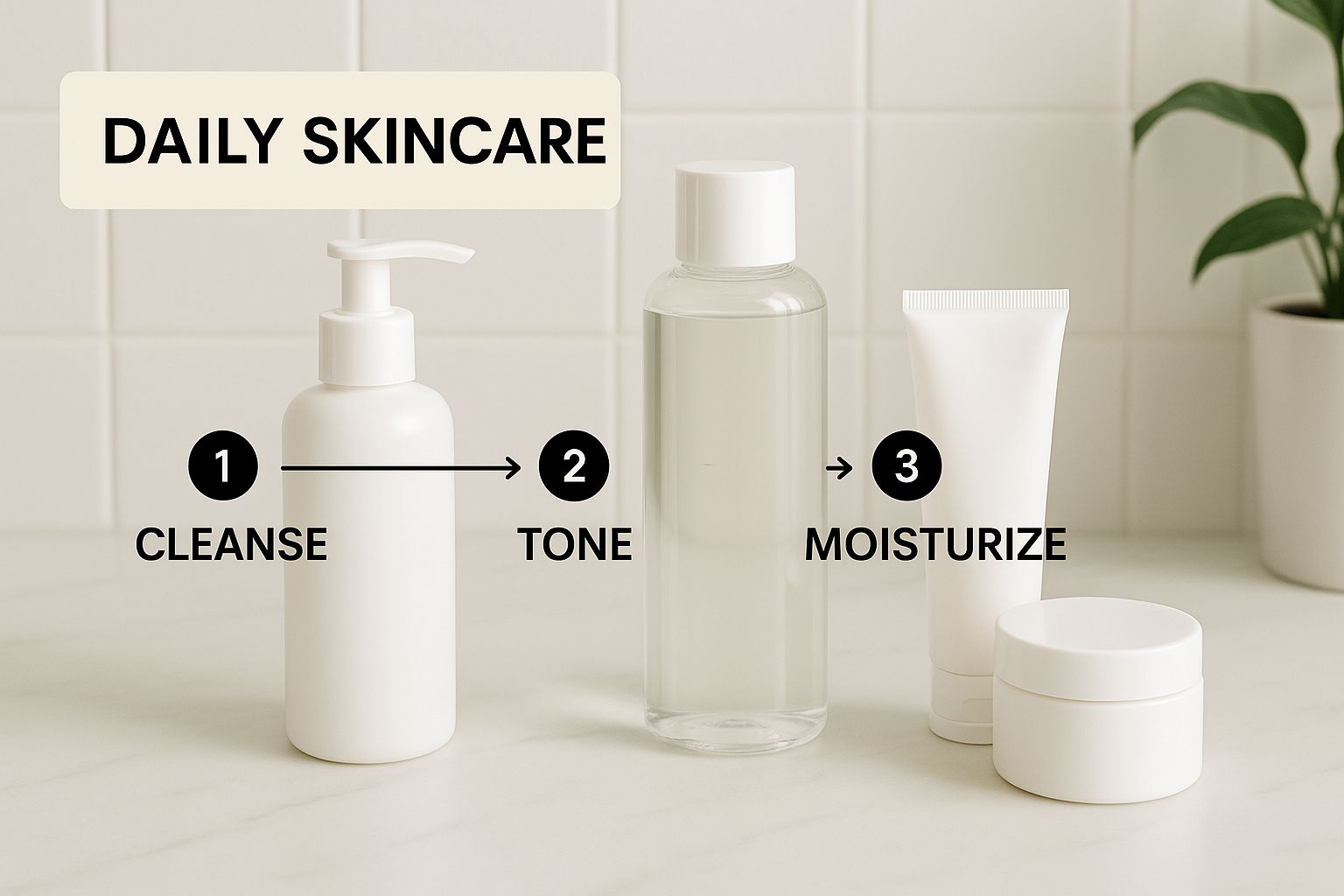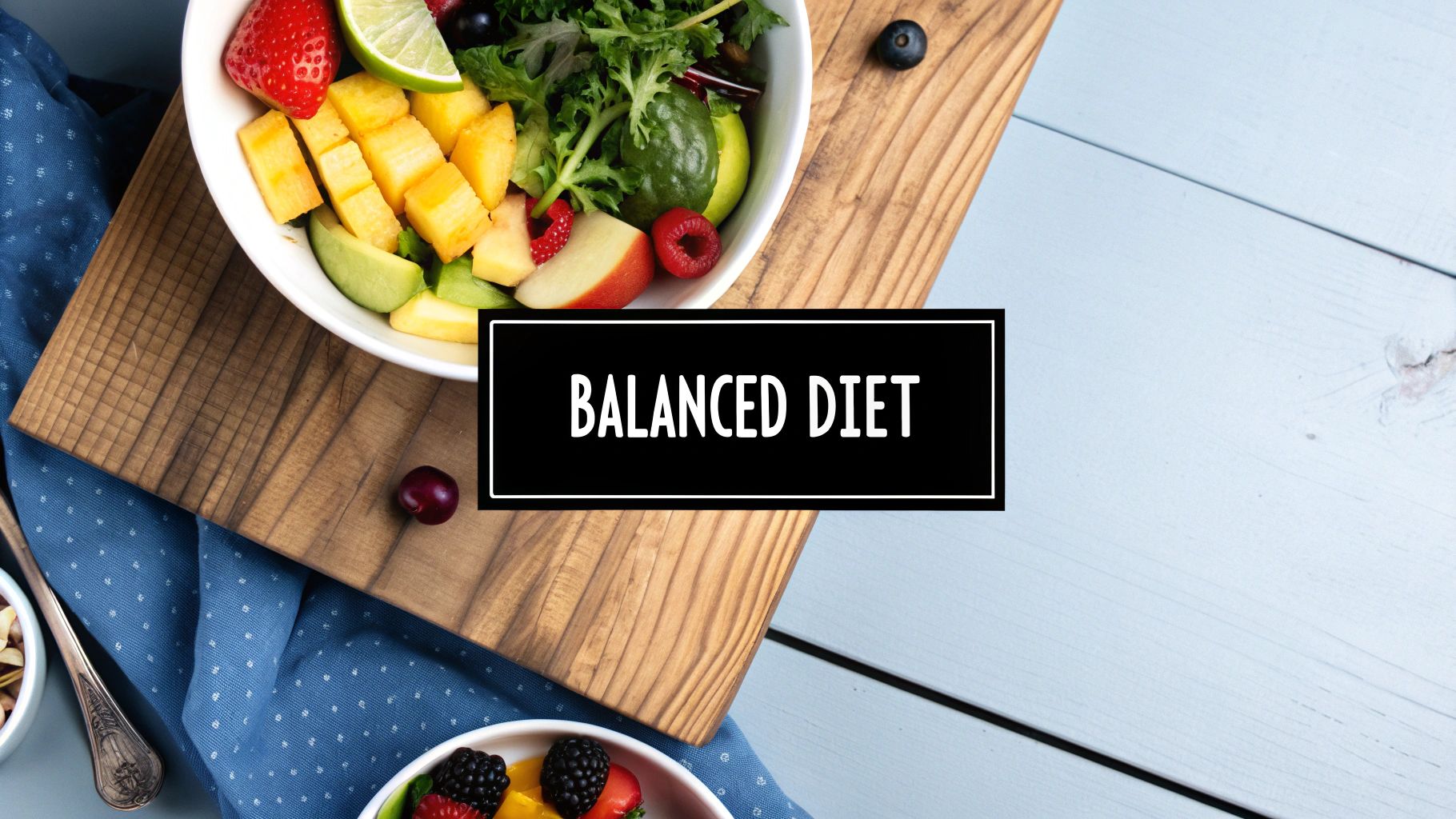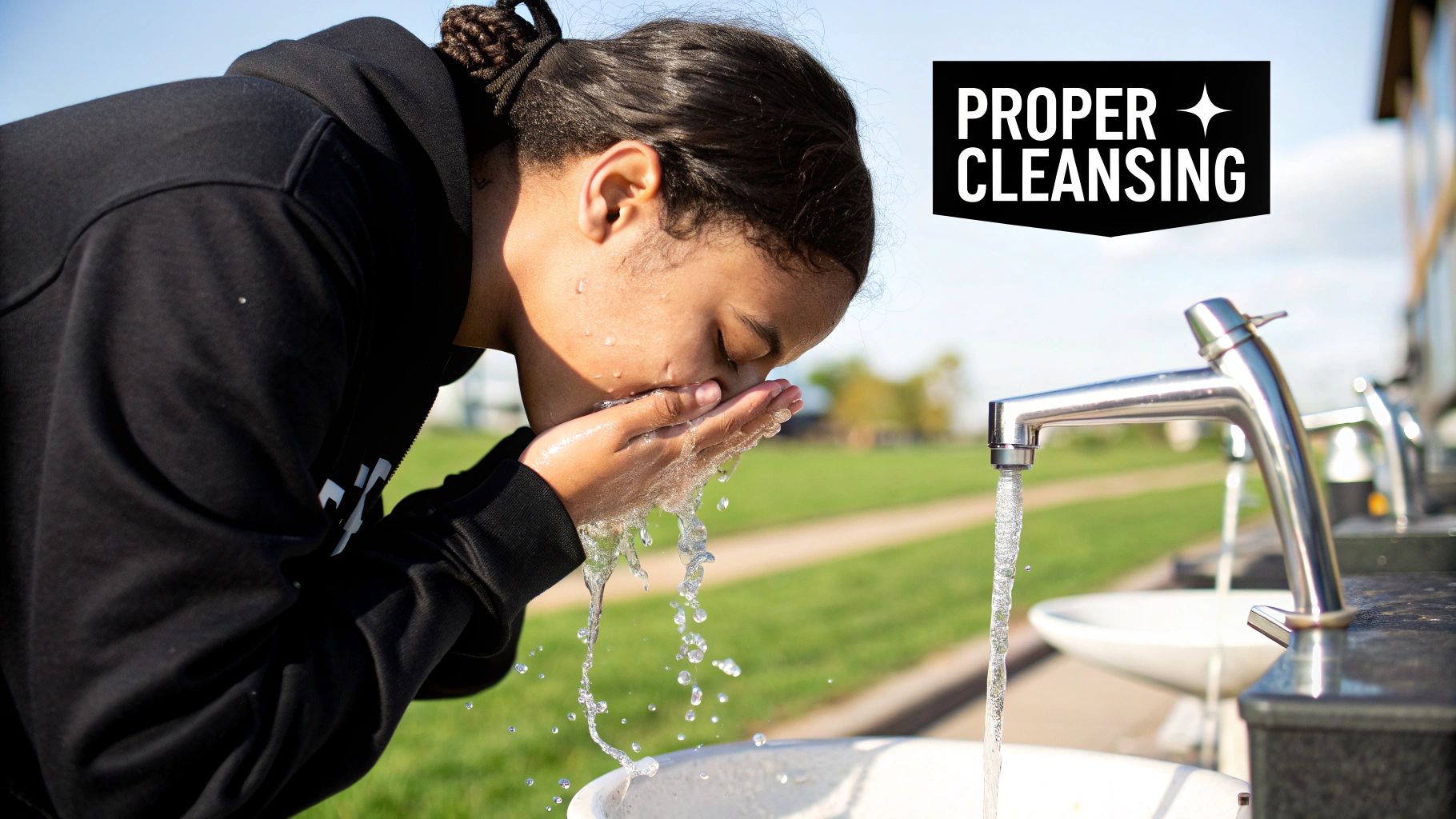
How to Prevent Acne Breakouts: Expert Tips for Clear Skin
Share
It feels like one day your skin is behaving, and the next, a fresh breakout has appeared out of nowhere. If that sounds familiar, you're not alone. The key to getting off this frustrating rollercoaster isn't just treating spots as they appear, but understanding what's happening under the surface to stop them in their tracks.
Forget the myth that acne is about having ‘dirty’ skin. It’s actually a complex biological cycle, and once you understand the moving parts, you can build a routine with the right skin care products that truly works.
Why Acne Breakouts Happen and How to Stop Them
Think of every spot as the end result of a tiny domino effect that starts deep within your pores, or hair follicles. To get ahead of breakouts, we need to interrupt that chain reaction.
The Four Key Triggers of a Breakout
The journey from a clear pore to an angry, red blemish almost always involves these four key players. When you realise how they work together, preventing them becomes much more manageable.
-
Excess Sebum (Oil) Production: Your skin produces a natural oil called sebum to keep itself healthy and moisturised. But sometimes, things like hormonal shifts, genetics, or even stress can send your oil glands into overdrive. This creates a slick, oily environment where problems can start.
-
Clogged Pores: Our skin is constantly shedding dead cells. Normally, this process goes unnoticed. But when there's too much sebum around, those dead cells become sticky. They clump together with the excess oil and form a plug that blocks the pore. This is the very first, invisible stage of a spot, called a microcomedone.
-
Bacteria Buildup: We all have a type of bacteria called Cutibacterium acnes (or C. acnes) living on our skin, and most of the time, it's completely harmless. However, a clogged pore is its ideal home: a cosy, airless space packed with its favourite food (oil and dead cells). This allows the bacteria to multiply rapidly.
-
Inflammation: Your immune system is smart. It quickly detects the overgrowth of C. acnes bacteria and flags it as a threat, launching an inflammatory attack to fight it off. This immune response is what causes the classic signs of a pimple: redness, swelling, and soreness.
The goal of a great skincare routine isn't just damage control. It's about proactively managing these four factors with the right skin care products to keep pores clear, balance oil, and reduce inflammation. It’s about stopping the dominoes from falling in the first place.
A Common Concern Across the UK
If you're dealing with acne, it's worth remembering just how incredibly common it is. It's not a niche issue; it’s a shared experience.
In the UK, acne affects a staggering 95% of people at some point in their lives, making it one of the most prevalent skin conditions out there. Recent statistics show that rates are actually on the rise, increasing from 8,563 per 100,000 people in 1990 to 9,790 per 100,000 in 2021. It's a significant concern, leading to around 3.5 million GP appointments every single year. You can discover more about the latest acne statistics and what they mean for people across the country.
Building Your Daily Anti-Acne Skincare Routine
Getting into a solid daily skincare routine is your strongest defence in the fight for clear skin. It's not about spending hours on a complicated, 10-step ritual. Instead, it’s about consistent, targeted care using the best skin care products for your needs. Let's walk through a practical framework for a simple morning and evening routine that genuinely works.
Having your skin care products organised and ready to go can make all the difference in staying consistent. This is just as important as the products themselves.

Think of it this way: if your routine is simple and your products are within reach, you're far more likely to stick with it day in and day out. That consistency is what prevents breakouts.
Your Morning Skincare Blueprint
Your morning routine has one main job: to gently cleanse away anything that built up overnight and to protect your skin from the day ahead. You’re essentially setting your skin up for success.
Start with a gentle cleanse. I can't stress this enough. Use a mild, non-stripping cleanser and lukewarm water—hot water can be irritating, while cold water won't properly dissolve oils. When you're done, gently pat your face dry with a clean towel. Rubbing causes friction and inflammation, which is the absolute last thing acne-prone skin needs.
Next up, apply a targeted serum if that's part of your routine, followed by a non-comedogenic moisturiser. That term is your new best friend; it simply means the product is formulated so it won’t clog your pores. And yes, even oily skin needs hydration. Skipping moisturiser can actually signal your skin to produce even more oil to compensate.
Finally, the most critical step of all is sun protection. Sun exposure can make inflammation worse and leave you with stubborn dark marks (post-inflammatory hyperpigmentation) long after a spot has healed. Always, always use a broad-spectrum sunscreen with an SPF of 30 or higher. Look for skin care products labelled "oil-free" or "non-comedogenic" that are specifically designed for the face.
Your Evening Skincare Strategy
Your evening routine is all about removing the day—makeup, SPF, pollution, and grime—and then applying your most powerful treatment products. Your skin shifts into repair mode at night, so you want to give it the best possible environment to do its job.
If you wear makeup or sunscreen (and I hope you do!), a double cleanse is non-negotiable.
- First Cleanse (Oil-Based): Start with an oil-based cleanser or micellar water. This first step is designed to melt away and dissolve all the stubborn, oil-based impurities like makeup and SPF.
- Second Cleanse (Water-Based): Follow up with your regular gentle, water-based cleanser. This gets deep into the pores, washing away any leftover residue and leaving your skin perfectly clean.
With a clean slate, it's time for your active treatments. This is the moment to apply products with ingredients like salicylic acid, benzoyl peroxide, or retinoids. These powerhouse skin care products need to be applied to completely clean skin to be truly effective.
Pro Tip: I always recommend waiting a minute or two between applying different product layers. This gives each one a chance to absorb properly without pilling or being diluted by the next, which really boosts its effectiveness.
A simple, consistent routine is far more powerful than a sporadic, complex one. To get an idea of how these steps come together with specific product types, have a look at this detailed guide on the best skincare routine for acne-prone skin—it's a great resource for simplifying product selection.
To make it even clearer, here’s how the two routines compare side-by-side.
Your Morning vs. Evening Anti-Acne Routine
This table breaks down the core purpose of each routine and the essential steps involved. While they share some similarities, their primary goals are quite different.
| Step | Morning Routine (AM) | Evening Routine (PM) | Key Goal |
|---|---|---|---|
| 1. Cleanse | Gentle, water-based cleanser | Double Cleanse: Oil-based then water-based cleanser | Remove overnight build-up (AM) / Remove SPF, makeup & daily grime (PM) |
| 2. Treat | Targeted serum (e.g., Vitamin C, Niacinamide) | Active treatments (e.g., Salicylic Acid, Retinoids) | Address specific concerns like brightening or oil control (AM) / Exfoliate, unclog pores & promote cell turnover (PM) |
| 3. Hydrate | Lightweight, non-comedogenic moisturiser | Non-comedogenic moisturiser (can be richer) | Maintain skin barrier and prevent dehydration |
| 4. Protect | Broad-spectrum SPF 30+ | Not applicable | Shield skin from UV damage, which can worsen acne and scarring |
By building this simple yet effective daily habit, you’re proactively working to prevent acne rather than just reacting to it. Consistency with this morning and evening framework is your blueprint for achieving and maintaining clearer, healthier skin.
Choosing Skin Care Products That Prevent Acne
Staring at a skincare aisle packed with bottles all promising clear skin can be completely overwhelming. I’ve been there. The real secret to cutting through that noise isn’t about buying more products; it’s about understanding the ingredients inside them. Once you know what to look for on a label, you can make truly smart choices for your skin.

Knowing a bit about the science behind these ingredients turns that confusion into confidence. Let's get into the actives that genuinely work, so you know exactly which skin care products to grab off the shelf.
The Pore-Clearing Powerhouses
Some ingredients are famous for a good reason—they get right to the heart of what causes acne. Figuring out how each one works helps you pick the right tool for the job.
-
Salicylic Acid (BHA): This is my top pick for anyone struggling with clogged pores. Because it's oil-soluble, it can actually get inside the pore to break down that stubborn mix of oil and dead skin that leads to spots. It’s brilliant for clearing out blackheads and whiteheads before they get angry and inflamed.
-
Benzoyl Peroxide: Think of this as your secret weapon against the C. acnes bacteria. It works by releasing oxygen into the pore, which creates an environment where acne-causing bacteria simply can't thrive. It’s incredibly effective for those red, painful pimples, but it can be drying. My advice? Always start with a lower concentration, like 2.5% or 5%, to see how your skin handles it.
-
Retinoids (Retinol & Adapalene): These are derivatives of Vitamin A, and they work by hitting the fast-forward button on your skin's renewal process. By speeding up cell turnover, they stop dead skin cells from building up and forming clogs in the first place. Adapalene, which you can now get over the counter, is especially good for acne and is often tolerated much better than stronger prescription options.
A Quick Tip from Experience: When you're adding any new active ingredient to your routine, please start slow. I mean it. Use it just a couple of times a week at night to begin with. You can slowly build up from there as your skin gets used to it. This is the best way to avoid ending up with a dry, irritated face.
Calming and Balancing Supporting Acts
While those ingredients are the heavy hitters, a good routine needs a solid supporting cast to keep things calm and balanced.
One of the most valuable players here is Niacinamide (Vitamin B3). It’s a real multi-tasker. It helps get oil production under control, calms down the redness and swelling that comes with breakouts, and even strengthens your skin’s barrier. This makes it a fantastic partner for more intense actives like retinoids, as it can help counteract some of that potential irritation. If you're looking for other gentle but powerful options, have a look at our guide on the https://p-eleven.com/blogs/best-natural-acne-treatments.
Here in the UK, we face specific challenges like growing antibiotic resistance and sometimes limited access to certain treatments. This has pushed the focus towards smarter, non-antibiotic solutions that target oil and inflammation from the get-go. Modern dermatology is all about prevention. The idea is to control these factors early, reducing the need for antibiotics down the line. By choosing skin care products with proven ingredients like salicylic acid and niacinamide, you’re already following this modern, preventative mindset.
Lifestyle Habits That Support Clear Skin
What you do beyond the bathroom sink can have a profound impact on your skin's health. While a solid daily skincare routine is your first line of defence, truly preventing acne often means taking a closer look at your wider lifestyle. Think of it this way: these small, consistent adjustments support all the hard work you're putting in with your skin care products.

The Diet and Acne Connection
The link between what you eat and the state of your skin is a hot topic, but from my experience, some patterns are hard to ignore. No single food will be a guaranteed trigger for everyone, but being mindful of certain food groups can be a genuine game-changer.
Research points towards a connection between high-glycaemic foods and acne. These are things that cause your blood sugar to spike quickly – think white bread, sugary snacks, and some processed cereals. This spike can kick off a hormonal cascade that may increase oil production and inflammation.
Similarly, some people find that dairy, especially cow's milk, can make their breakouts worse. You don't need to launch into a super-restrictive diet, but it might be worth paying attention to how your skin reacts after you’ve had a lot of these foods. It's more about mindful observation than strict elimination.
Managing Stress for Clearer Skin
Ever noticed a new spot popping up right before a big exam or an important meeting? That’s no coincidence. Stress is a well-known acne trigger.
When you're stressed, your body produces more cortisol and other hormones that can send your skin’s oil glands into overdrive. All that extra oil creates the perfect breeding ground for breakouts.
Finding ways to manage stress isn't just good for your mind; it's a practical skincare step. Simple practices like getting a full night's sleep, going for a walk, or even just five minutes of deep breathing can help regulate your body's stress response and, in turn, calm your skin.
Avoiding Breakouts from Friction
Sometimes, spots aren't caused by internal factors but by simple physical irritation. We call this acne mechanica, and it’s the result of friction, pressure, or rubbing against the skin. This constant irritation can trap sweat and bacteria, leading to clogged pores along your jawline, cheeks, or forehead.
Luckily, preventing this type of acne is all about simple habit changes.
- Clean Your Phone Screen: Your phone is a magnet for bacteria. Give it a daily wipe with an antibacterial wipe to stop transferring that grime to your cheek every time you take a call.
- Change Your Pillowcase: I recommend changing your pillowcase at least twice a week. Oils from your hair and skin, plus product residue, build up on the fabric and can easily clog your pores while you sleep.
- Be Mindful of Headwear: If you often wear hats, headbands, or helmets, make sure they’re clean and not too tight. The combination of sweat and friction is a major cause of forehead breakouts for many people.
Common Skincare Mistakes That Worsen Acne
Sometimes, the biggest leap forward in your skincare journey isn't about what you add, but what you stop doing. I see so many well-intentioned clients who are accidentally sabotaging their skin with a few common habits. Honestly, avoiding these pitfalls is just as important as building the perfect routine with the right skin care products.
One of the most frequent issues I see? Being far too aggressive. It’s a natural impulse to think that scrubbing harder or using harsh, stripping cleansers will get your skin cleaner and, therefore, clearer. But in my experience, this approach almost always backfires.
Over-Exfoliating and Stripping Your Skin
When you go at your face with grainy scrubs or use cleansers that leave it feeling tight and ‘squeaky clean’, you're actually damaging your skin's natural protective barrier. Think of this barrier as your skin's first line of defence – it’s crucial for locking moisture in and keeping irritants out.
Stripping away all those natural oils sends your skin into panic mode. The sebaceous glands get a signal that the surface is dry and vulnerable, so they overcompensate by producing even more oil. This kicks off a frustrating cycle of oiliness and irritation, leaving you more prone to clogged pores than before.
My advice? Stick to a gentle, pH-balanced cleanser and ease up on exfoliation. Chemical exfoliants, like those with salicylic acid, are usually a much better bet than harsh physical scrubs, and even then, you only need to use them a few times a week.
A healthy skin barrier is your best defence against acne. The goal is to support it, not attack it. If your skin feels tight, red, or irritated after washing, your cleanser is likely too strong.
The Myth of Skipping Moisturiser
I get it. If you have oily skin, the thought of slathering on moisturiser can feel completely wrong. But believe me, skipping this step is a critical mistake. Even the oiliest skin needs hydration, which is all about its water content, not its oil content.
When your skin becomes dehydrated, it behaves just like stripped skin: it ramps up oil production to try and protect itself. The solution is finding the right skin care product: a lightweight, non-comedogenic (meaning it won't clog pores), and oil-free moisturiser. This gives your skin the water it needs without adding extra grease, helping to bring everything back into balance.
Picking, Popping, and Squeezing
We've all been there. Staring in the mirror, tempted to just get rid of that spot. But picking is a surefire way to make everything worse.
Every time you squeeze a pimple, you create a real risk of pushing bacteria and inflammation deeper into the skin. This not only makes the spot redder and more painful, but it also dramatically increases the chances of permanent scarring. This trauma can lead to post-inflammatory hyperpigmentation (those stubborn dark marks) or atrophic, pitted scars.
Learning how to fade acne scars is a much longer and more difficult process than simply letting a spot heal on its own. Keep your hands off your face—it's one of the kindest things you can do for your skin.
Your Acne Questions, Answered
Even when you've got a solid routine dialled in, questions will inevitably crop up. Getting straightforward answers to those tricky "what if" scenarios is crucial for staying on track. Let's tackle some of the most common questions I get asked about preventing breakouts.
Think of this as your go-to guide for navigating those confusing moments. Getting a handle on these details is what separates a good routine from a great one that delivers long-term results.
Is My Makeup Causing My Breakouts?
This is a big one, and the short answer is yes, it absolutely can. Many makeup products contain certain oils, fragrances, or pigments that can clog pores, leading to a specific type of acne called acne cosmetica. You’ll often see this as small, rash-like bumps, usually across the cheeks, chin, and forehead.
The key is to be selective about your skin care products, including makeup. Always look for products labelled "non-comedogenic" or "oil-free" – they're formulated specifically to avoid blocking pores. Just as important is getting it all off at the end of the day. A double cleanse every single night is non-negotiable if you wear makeup. No exceptions!
How Long Until I See Results from a New Routine?
Patience is a virtue in skincare, but it's often the hardest part of the journey. We all want to see changes overnight, but real results take time and, most importantly, consistency.
As a rule of thumb, give any new skin care products and routine at least 8 to 12 weeks before you make a call on whether it's working. That's roughly how long it takes for active ingredients to influence your skin's renewal cycle and start calming inflammation.
Don't be surprised if your skin goes through a "purging" phase, either. It can sometimes look a bit worse before it gets better, especially when you introduce ingredients like retinoids or salicylic acid that accelerate cell turnover. This process brings underlying congestion to the surface. Unless you're experiencing serious redness, burning, or irritation, try to stick with it.
When Is It Time to See a Doctor?
High-street skin care products are fantastic for getting mild to moderate acne under control, but there are times when you just need stronger, prescription-level stuff. It’s probably time to book an appointment with your GP or a dermatologist if you're dealing with any of these issues:
- Painful, Deep Cysts: You have large, sore lumps under the skin that never seem to form a head.
- Scarring: Your spots are leaving behind permanent discolouration or indented scars.
- No Improvement: You've stuck with a good over-the-counter routine for three months or more with nothing to show for it.
- Significant Emotional Distress: The state of your skin is seriously impacting your self-esteem, confidence, or mental wellbeing.
Acne isn't just a cosmetic issue in the UK; it's a major health concern. Young adults between 16 and 24 are the most affected group. To put it in perspective, NHS England spent around £22.7 million on prescribed topical acne treatments in just one year. This shows just how many people need professional medical help. You can read more about these UK acne statistics to see the full picture.
A doctor has access to treatments you can't get over the counter, like stronger prescription retinoids or oral medications. They can build a plan that's right for you and give you the best shot at finally getting clear.
At P-Eleven, we believe that understanding your skin is the first step towards transforming it. Our curated collections of natural, science-backed skin care products are designed to support your journey to clear, healthy skin with targeted solutions for every concern. Discover your ideal routine at https://p-eleven.com.